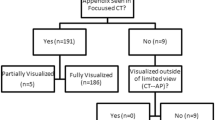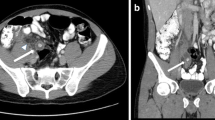Abstract
The purpose of this study was to assess the feasibility of diagnosing appendicitis based on coronal reformations without the aid of transverse images. Abdominal and pelvic computed tomography (CT) scans of 53 patients (27 with appendicitis and 26 without appendicitis) were reviewed. All scans were obtained using a four-slice multi-detector row CT. The radiologists were not aware of the final diagnosis. Cases were reviewed for the visualization of the appendix and presence of appendicitis. All images were reviewed on picture archiving and communication systems. There were no false positives for diagnosing appendicitis when using either the transverse or coronal reformations. Appendicitis was not seen on the coronal images in one case, and there were no false negatives when transverse reformations alone were used. This difference was not statistically significant (p < 0.0001 for both modes of display). The sensitivity for diagnosing appendicitis based on the coronal images alone was 96%, the specificity was 100%, and the accuracy was 98%. Coronal reformations decreased the number of images reviewed by 19%. CT diagnosis of appendicitis based on the coronal images is accurate.


Similar content being viewed by others
References
Sarosi GA, Turnage RH (2002) Appendicitis. In: Feldman M, Friedman LS, Sleisenger MH (ed) Sleisenger & Fordtran’s gastrointestinal and liver disease, 7th edn. Saunders, Philadelphia, pp 2089–2099
Lane MJ, Liu DM, Huynh MD, Jeffrey RB, Jr., Mindelzun RE, Katz DS (1999) Suspected acute appendicitis: nonenhanced helical CT in 300 consecutive patients. Radiology 213:341–346
Velanovich V, Satava R (1992) Balancing the normal appendectomy rate with the perforated appendicitis rate: implications for quality assurance. Am Surg 58:264–269
Graff L, Russell J, Seashore J et al (2000) False-negative and false-positive errors in abdominal pain evaluation: failure to diagnose acute appendicitis and unnecessary surgery. Acad Emerg Med 7:1244–1255
Rusnak RA, Borer JM, Fastow JS (1994) Misdiagnosis of acute appendicitis: common features discovered in cases after litigation. Am J Emerg Med 12:397–402
Von Titte SN, McCabe CJ, Ottinger LW (1996) Delayed appendectomy for appendicitis: causes and consequences. Am J Emerg Med 14:620–622
Brandt MM, Wahl WL (2003) Liberal use of CT scanning helps to diagnose appendicitis in adults. Am Surg 69:727–731
Paulson EK, Kalady MF, Pappas TN (2003) Suspected appendicitis. N Engl J Med 348:236–242
Shelton T, McKinlay R, Schwartz RW (2003) Acute appendicitis: current diagnosis and treatment. Curr Surg 60:502–505
Torbati SS, Guss DA (2003) Impact of helical computed tomography on the outcomes of emergency department patients with suspected appendicitis. Acad Emerg Med 10:823–829
Balthazar EJ, Rofsky NM, Zucker R (1998) Appendicitis: the impact of computed tomography imaging on negative appendectomy and perforation rates. Am J Gastroenterol 93:768–771
Rao PM, Rhea JT, Novelline RA, Mostafavi AA, McCabe CJ (1998) Effect of computed tomography of the appendix on treatment of patients and use of hospital resources. N Engl J Med 338:141–146
Hu H, He HD, Foley WD, Fox SH (2000) Four multidetector-row helical cT: image quality and volume coverage speed. Radiology 215:55–62
Flohr TG, Schaller S, Stierstorfer K, Bruder H, Ohnesorge BM, Schoepf UJ (2005) Multi-detector row CT systems and image-reconstruction techniques. Radiology 235:756–773
Jaffe TA, Nelson RC, Johnson GA et al (2006) Optimization of multiplanar reformations from isotropic data sets acquired with 16-detector row helical CT scanner. Radiology 238:292–299
Rydberg J, Buckwalter KA, Caldemeyer KS et al (2000) Multisection CT: scanning techniques and clinical applications. RadioGraphics 20:1787–1806
Paulson EK, Jaffe TA, Thomas J, Harris JP, Nelson RC (2004) MDCT of patients with acute abdominal pain: a new perspective using coronal reformations from submillimeter isotropic voxels. Am J Roentgenol 183:899–906
Jan YT, Yang FS, Huang JK (2005) Visualization rate and pattern of normal appendix on multidetector computed tomography by using multiplanar reformation display. J Comput Assist Tomogr 29:446–451
Paulson EK, Harris JP, Jaffe TA, Haugan PA, Nelson RC (2005) Acute appendicitis: added diagnostic value of coronal reformations from isotropic voxels at multi-detector row CT. Radiology 235:879–885
Kundra V, Silverman PM (2003) Impact of multislice CT on imaging of acute abdominal disease. Radiol Clin North Am 41:1083–1093
Schmidt S, Chevallier P, Chalaron M et al (2005) Multidetector CT enteroclysis: comparison of the reading performance for axial and coronal views. Eur Radiol 15:238–246
Rubin GD (2000) Data explosion: the challenge of multidetector-row CT. Eur J Radiol 36:74–80
Sherbondy AJ, Holmlund D, Rubin GD, Schraedley PK, Winograd T, Napel S (2005) Alternative input devices for efficient navigation of large CT angiography data sets. Radiology 234:391–398
Lee KH, Kim YH, Hahn S et al (2006) Added value of coronal reformations for duty radiologists and for referring physicians or surgeons in the CT diagnosis of acute appendicitis. Korean J Radiol 7:87–96
Nikolaidis P, Hwang CM, Miller FH, Papanicolaou N (2004) The nonvisualized appendix: incidence of acute appendicitis when secondary inflammatory changes are absent. Am J Roentgenol 183:889–892
Jacobs JE, Birnbaum BA, Macari M et al (2001) Acute appendicitis: comparison of helical CT diagnosis—focused technique with oral contrast material versus nonfocused technique with oral and intravenous contrast material. Radiology 220:683–690
Birnbaum BA, Wilson SR (2000) Appendicitis at the millennium. Radiology 215:337–348
Author information
Authors and Affiliations
Corresponding author
Rights and permissions
About this article
Cite this article
Yaghmai, V., Brandwein, W.M., Hammond, N. et al. MDCT diagnosis of appendicitis using only coronal reformations. Emerg Radiol 14, 167–172 (2007). https://doi.org/10.1007/s10140-007-0610-4
Received:
Accepted:
Published:
Issue Date:
DOI: https://doi.org/10.1007/s10140-007-0610-4




